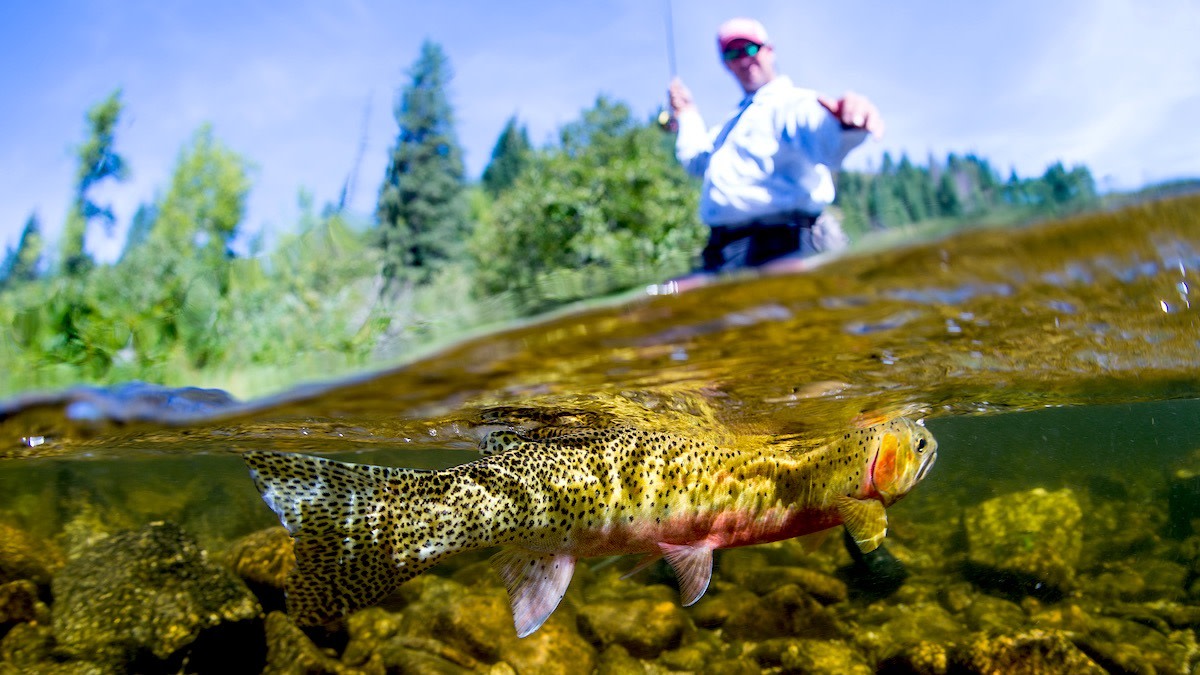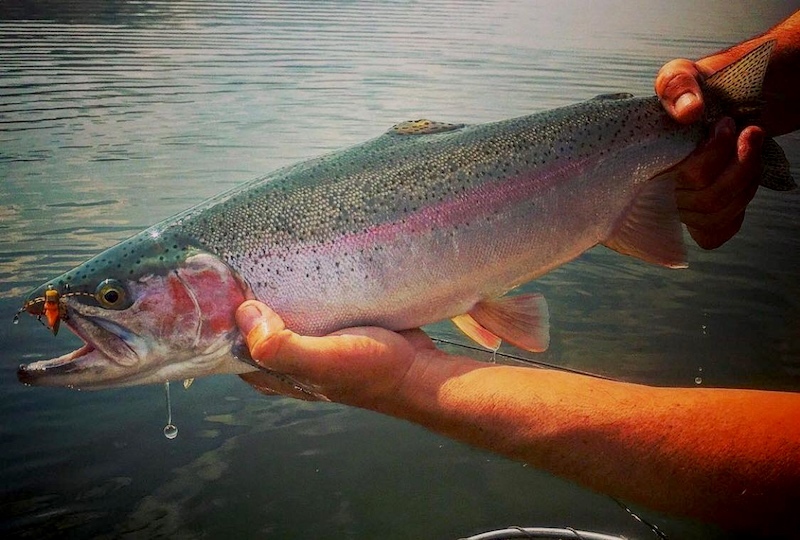
One of the most commonly frustrating elements of dry fly fishing is matching the hatch. While you will sometimes see dozens of trout rising to hatches so thick you get bugs in your mouth as you scramble down to the river, those moments are rare. Most of the time you’re faced with a pod of rising trout that ignore your carefully-drifted offerings so casually that you feel the desire to snap your fly rod in half and take up golf. But there is another dry fly tactic that trout will rise to and eat willingly, and this one won’t leave you snatching frantically at fluttering bugs screaming “What are you?!” like a deranged lunatic. I’m talking about terrestrial insects.
Terrestrials are useful and effective in spring, summer, and fall. This bug activity tends to heat up in the afternoon when most aquatic hatches like mayflies and caddis are tapering off or have yet to begin. These patterns can also be fished blind. Just casting and drifting terrestrial patterns over likely areas can bring trout to the surface, so you don’t have to hunt the river for rising fish all day. Think of it like a secret weapons to keep in your back pocket for use whenever the hatches aren’t showing up or the fishing gets tough. But you have to know when and how to use them correctly.
What are Terrestrial Insects? Unlike mayflies, caddisflies, and stoneflies—which spend their whole lives in and around the water getting eaten by trout—terrestrial insects are land-dwelling bugs that fall or fly into the river by accident, providing trout with a change in diet. These bugs can include everything from cicadas and crickets to caterpillars and bees. Any bug that creeps, crawls, or flies on land can fall in the river and be eaten by a fish—even butterflies.
While a lot of anglers might feel overwhelmed trying to tie up every little creepy crawler in existence or filling up their boxes with an entire insectarium, that need not be the case. The three bugs anglers should know and love are grasshoppers, beetles, and ants. These three insects have massive populations, are available throughout the fishing season, and are a regular part of a trout’s diet across much of the continent.

How to Fish Grasshopper Flies In the world of terrestrial fly fishing, grasshoppers are king. These oversized bouncing insects, often referred to as “hoppers,” emerge every summer between late June and early July, although they exist in fishable numbers as early as mid-May in some states. They can continue to catch fish until October. Hoppers climb up on tall grass stems along the riverbank to feed and often flutter or get blown into the water and provide trout with one hell of a meal. In fact, hoppers are such a large piece of meat that the bigger, more carnivorous trout normally caught only on streamers will willingly rise to eat hoppers on the surface. They are the T-bone steaks of the terrestrial world.
Fishing hoppers is some of the most thrilling dry fly fishing an angler can have. On warm, bright days when the fish are hungry and hoppers are bouncing, the action can be so fast and furious that fish seem to explode on your flies with nearly every cast. You just have to know how and where to fish them.
While some hoppers fly out over the water fall in the middle of the river, most of them tend to drop in the water along the banks. In larger rivers, look for deep, slow-moving holes along the riverbank, undercut banks where big fish can hide, and in front of or behind current breaks such as rocks and submerged logs. Cast and drift your hoppers along these areas, remembering that hoppers rarely hold still when they first hit the water. Don’t be afraid to give them a twitch or two. In smaller streams, plop hoppers down in the center of slow-moving pools. You can also run them down the center of deeper, fast-moving riffles where the trout won’t have a lot of time to look them over. Faster water makes for some spectacular reaction takes.
There are a ton of different options for hopper patterns, from hyper-realistic deer hair patterns to giant Day-Glo foam monstrosities that look like something from outer space. While a lot of anglers feel they need one of everything to be successful, keeping just a few contrasting hopper patterns in the box will cover all your bases. I prefer to carry some larger, gaudy hopper patterns for off-colored and faster water like the Moorish Hopper in green, yellow, and pink. For slower, clear water I like to use smaller, more detailed hopper patterns such as the Hopper Grande and the Letort Hopper in more natural colors like tan, olive, black, and gray. It can be helpful to cycle through patterns and colors to figure out the fishes’ preference that day.
How to Fish Ant Flies If the hopper is the T-Bone of the terrestrial world, then the ant is the candy bar. It’s widely believed that trout actually like the taste of ants. While this is hard to prove, trout will rise up to sip an ant when absolutely nothing else is working. Maybe trout like the taste of ants, but it’s more likely that there are so many falling into the river at so many different times of the year that trout constantly consider them a target of opportunity.
There are more than 1,000 species of ants in North America. Some crawl, some fly, some get blown around by the wind, but all of them are happily eaten by trout. Ants come in a massive variety of sizes and colors and at times can be the most valuable fly patterns in your box. I like to use ants as prospecting patterns, tying them on first both on waterbodies I’ve never fished before and rivers I’m familiar with. This is a great way to find where the trout are hanging out. Ants also work great when I’m unable to match the hatch or during extremely heavy hatches—unmatching the hatch, if you will. When trout can’t pick out my fly with so many real mayflies or caddisflies passing over their heads, they’ll pick out an ant in the crowd almost every time.
The best places to fish ants are in relatively shallow, slow-moving water of 2 to 5 feet deep with a lot of cover along the bank such as thick brush and overhanging logs. These are places where ants are likely to fall into the water and the trout are accustomed to seeing them. When I fish ants, I prefer to double up, using two dry flies with a larger lead fly and smaller, different colored pattern as a dropper. For the lead fly I choose to use a simple foam ant pattern in black or brown such as a Skilton Quick Sight Ant or Carl’s Foam Flying Ant. My dropper is usually a smaller, more detailed pattern like a Travis Para Ant or an Ant Acid. Once you see which ant pattern the trout prefer, you can tie on two and double your catches.
How to Fish Beetle Flies Beetles are an incredibly overlooked and underutilized fly pattern. A lot of anglers don’t know how often trout eat them, but there are over 30,000 species of beetle fluttering, crawling, and hopping around the riverbanks of North America. Many beetle species grow quite large and, like hoppers, can draw big predatory trout to the surface to feed. Furthermore, there are so many species of beetle around that, like ants, trout are used to seeing them in the water and will rise to them willingly when presented with an opportunity. It amazes me how few anglers seem to know this.
Beetles seem to work best in faster moving water where trout come to the surface quickly to feed and don’t have a lot of time to look over the bugs flying by in the fast current. Plunk them down in boulder-filled riffles and fast, deep runs in the center of the river or stream. With that said, I’ve also had success using beetle flies on slow-flowing, gin-clear spring creeks and alpine lakes and ponds when nothing else was working. So, don’t be afraid to fish them in other places. Beetles are the ultimate back-up plan and no matter where or when you are fishing, you should try beetle patterns periodically when you find yourself stumped.
The wide variety of beetle species means that trout will feed on them opportunistically and won’t be too particular about patterns, so keep your beetle selection basic. Choose two or three larger foam patterns such as the Fat Albert in a variety of colors to plop down in faster water and a couple of smaller patterns like a Rosenbauer Parachute Beetle and a Flash Beetle for trout to rise up and crush in slower water, where they might be more finicky. It’s hard to beat black for color, but you might experiment with a little flash or brighter hues.
Don’t Disgrace the Fish by Catching Them One the most thrilling sights in the fishing experience is that of a giant trout rising slowly to sip a drifting fly from the surface of the water. It’s an iconic image and the reason many of us picked up a fly rod in the first place. Yet so often those fantastic dry fly dreams slowly warp into nightmares. Picky trout, unidentifiable insects, and having to wait on the bank for erratic hatches that may never arrive cause a lot of dry fly anglers to get twitchy and start throwing on bobbers. Fishing terrestrials offers more opportunities that don’t depend so much on matching the hatch or mending a perfect drift. Hoppers, beetles, and ants are always around and will draw trout to the surface on the hatchless days, ensuring the iconic dry fly action you crave all trout season long.



